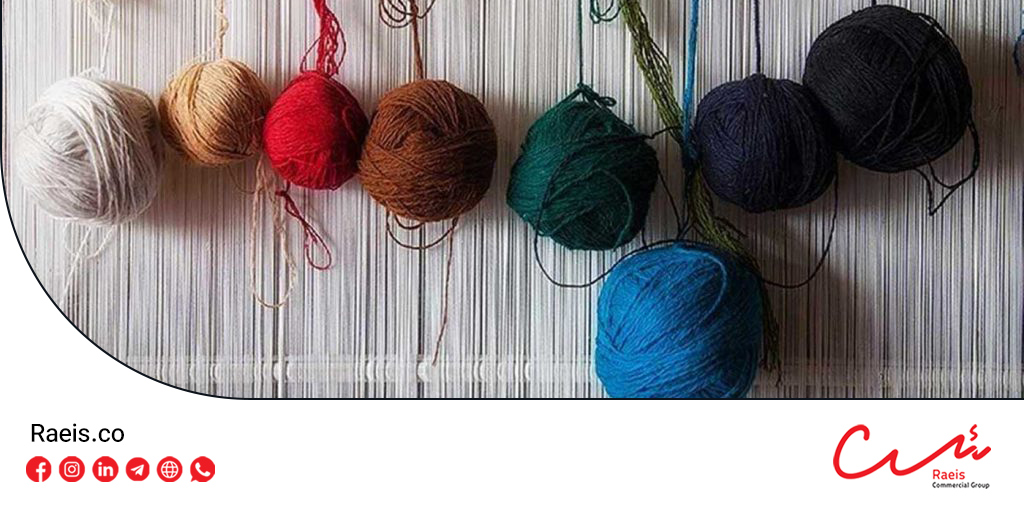What Types of Yarn Are Produced in Iran?

The textile industry is one of Iran’s key and longstanding sectors, playing a significant role in the country’s economy. Due to its rich natural resources such as cotton, wool, and silk, Iran has historically been recognized as a hub for fiber and yarn production in the Middle East. This industry not only meets domestic demands but also serves as a potential export sector. With advancements in technology and increased production capabilities, Iran now produces high-quality yarns in a variety of types to meet the diverse needs of the textile, clothing, and carpet industries.
This article, presented by Raeis Industrial Group, examines the various types of yarn produced in Iran, focusing on natural and synthetic yarns, their production processes, and applications to provide a comprehensive overview of the state of yarn production in the country.
Types of Yarn Produced in Iran
Iran’s yarn industry offers significant diversity, stemming from the use of various raw materials and production techniques. The yarns produced in Iran can be broadly categorized into two main groups: natural and synthetic. Below is a detailed look at each category.
Natural Yarns
Natural yarns are fibers derived from natural sources and are either used directly or converted into yarn through simple processes. These yarns are highly popular due to their unique characteristics, such as breathability and skin compatibility. The following are some types of natural yarns produced in Iran:
Cotton Yarn
Cotton yarn is one of the most widely used yarns in Iran. With fertile lands and suitable climatic conditions, provinces like Golestan, Khorasan, and Markazi are prominent in cotton production. This yarn, made from cotton fibers, is known for its softness, breathability, and excellent moisture absorption. As a natural material, cotton is suitable for a wide range of products, including clothing, bed linens, and household fabrics.
Wool Yarn
Wool yarn production is significant in Iran due to extensive livestock farming and access to natural wool, particularly in western and northwestern provinces like Kurdistan and Azerbaijan. This yarn, derived from sheep wool, is valued for its warmth and durability, making it ideal for winter clothing and hand-woven carpets.
Silk Yarn
Silk yarn is admired for its beauty and softness. Iran has a rich history of silk production, particularly in northern provinces like Gilan and Mazandaran, where traditional silk farming continues. While silk production in Iran is limited and primarily relies on traditional methods, efforts are underway to modernize production processes and expand export markets to meet the growing demand for high-quality silk products.
Synthetic Yarns
Synthetic yarns are fibers made from processed chemical materials and are widely used in the textile industry due to their specific properties. These yarns are generally more durable and resistant compared to natural yarns. The following are some types of synthetic yarns produced in Iran:
Polyester Yarn
Polyester yarn is one of the most commonly used synthetic yarns in Iran’s textile industry. Known for its high durability, wrinkle resistance, and quick-drying capability, it is extensively used in clothing, bed linens, and industrial fabrics. Polyester production in Iran is primarily carried out by large industrial factories, making the country a major producer of this yarn in the region.
Nylon Yarn
Nylon yarn is another popular synthetic fiber produced in Iran. With its high resistance and elasticity, nylon is used in various industries, including apparel, sports equipment, and industrial applications. Iranian manufacturers utilize advanced technologies to produce high-quality nylon yarns at competitive prices.
Acrylic Yarn
Acrylic yarn, a synthetic fiber known for its softness and moisture resistance, is widely used in clothing and knitted products. It is particularly popular during colder seasons and serves as a substitute for wool. Using advanced technologies and modern machinery, Iran produces high-quality acrylic yarns, which are well-received in both domestic and export markets due to their affordability and wool-like properties.
Challenges in Yarn Production in Iran
Despite its diversity and potential, Iran’s yarn industry faces several challenges that can affect production quality and quantity. One major challenge is the shortage of high-quality raw materials. Although Iran has substantial capacity in cotton and wool production, certain needs, especially in chemical materials for synthetic yarn production, are met through imports.
Additionally, modern production processes and machinery used in advanced countries are not sufficiently developed in Iran, which can reduce product quality and increase production costs. A lack of investment and outdated technologies in some factories further exacerbate these issues.
Conclusion
Iran’s yarn production industry, with its wide range of products and rich history, plays a vital role in the country’s economy. From natural yarns like cotton, wool, and silk to synthetic yarns like polyester, nylon, and acrylic, Iran has utilized its abundant resources to produce high-quality yarns.
Despite challenges such as raw material shortages and the need for investment in modern technologies, there are significant opportunities for the industry to grow. Addressing market demands, improving production quality, and adopting sustainable practices can enhance the competitiveness of Iranian products in both domestic and international markets.
Finally, Raeis Industrial Group’s comprehensive examination of yarn production in Iran demonstrates that with proper planning and optimal use of available capacities, the future of the country’s yarn and textile industry is promising. Collaboration among producers, the government, and the private sector is essential to establish supportive policies and infrastructure, paving the way for the industry’s progress and development.

